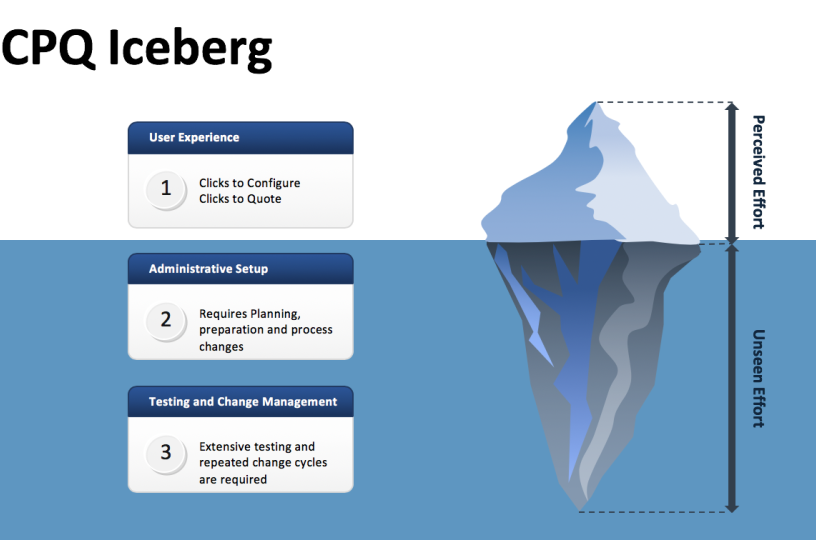Configure. Price. Quote.
Seems simple, right?
When done correctly, a CPQ program should seem simple. In fact, it can be one of the greatest assets to your business by helping to simplify processes, eliminate spreadsheets and speed sales cycles to generate more revenue.
But the appearance of simplicity is just that — an appearance. The most successful CPQ programs are actually quite complex underneath the surface. And this complexity is something for which you must prepare before you take on a CPQ project.
With that understanding in mind, what does it take to build a successful CPQ program? First and foremost, it’s important to know from the very beginning exactly what you are taking on and how you plan to do so. From there, I’ve found three key considerations that make all the difference to coming out successful on the other side. Here’s what you need to know:
1) Think Through the Entire CPQ Iceberg
The most effective CPQ programs are like icebergs, meaning frontline users only see a fraction of what’s actually going on.

Thinking through the iceberg analogy, at the very top of your CPQ program sits your user experience. Your goal is to make it as quick and easy as possible for users to interact with the CPQ tool. And that simple user experience should be the only part of your CPQ program that everyone actually sees.
Ironically, the simpler your user experience at the top, the more complexity you have below the surface. That’s because the less effort and more speed for users, the more automation you need on the backend. Far too often, when organizations take on CPQ programs and set out to create a fast, simple user experience, they underestimate the time it takes to build out the automation and guardrails to deliver on that goal — and that’s when problems ensue.
As a result, you must pay enormous attention to the part of your CPQ iceberg that sits under water by taking the time to implement the necessary configuration and user guidance correctly. Specifically, you must take on an administrative setup, including planning, preparation and process changes, and you need to handle testing and change management, which requires extensive testing and repeated change cycles.
2) Build to the 95% (Not the 5% Exception)
The best CPQ deployments focus on building features that the core set of users and departments require on a regular basis. These features should cover about 95% of what you need to satisfy everyone.
What about the remaining 5%? There will always be one offs and exceptions to overarching business rules, but if you try to build to every last one, you will end up significantly increasing the time, complexity and costs of the project. And given the complexity that occurs under water for the CPQ iceberg, that additional scope can end up being quite large. Along the way, you might also hinder the simplicity of the user experience by trying to take on too much at once.
Remember: As with any other technology, a CPQ program is not set it and forget it. It’s something you should build and improve on over time, so you can always plan for a phase two deployment to deliver those edge use cases. Saving this effort for phase two not only means you can get your program running faster so your business can start reaping the benefits, but it also allows you to use that performance to gain the necessary buy-in for the additional time and resources required to build the remaining features.
3) Get on the Same Page, Early
Finally, it’s critical to get your stakeholders — including all cross-functional teams that will use the system — on the same page regarding goals and core capabilities. And the earlier you can do so the better, since ensuring this alignment on project scope is essential to mapping out your project plan and keeping that plan in motion.
While this might seem like an obvious consideration, there are often more stakeholders than you think. In most organizations, finance, sales, legal and customer service teams are all core stakeholders for CPQ programs and each team’s everyday users will come to the table with different requirements and use cases. It’s critical to get representatives from each group together to hash out these differences and clearly define a shared set of goals.
In addition to securing this alignment as early as possible, you need to keep this group aligned going forward. Setting up regular check-ins to review progress and documenting the shared goals (along with their definitions) can go a long way toward maintaining alignment long term.
Are You Ready to Implement an Effective CPQ Program?
Ultimately, if you’ve built an effective CPQ program, it should appear extremely simple to anyone who comes across it. But getting to that appearance of simplicity takes a lot of work behind the scenes, and that complexity is something for which your team must prepare. Unfortunately, this hidden complexity takes many teams by surprise and, if not handled correctly, can lead to problems down the road.
However, you can avoid these challenges. Many organizations find that having a partner who understands the complexities of the CPQ iceberg and takes the time to build the backend right is worth the investment so that users are more successful in the long run. Whichever route you go, paying careful attention to the considerations outlined here will prove critical to your CPQ success.
Contributor: Jon Smith, VP, Solutions & Technical Enablement